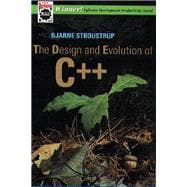
Bjarne Stroustrup is the designer and original implementer of C++, the author of The C++ Programming Language, The Annotated C++ Reference Manual, and The Design and Evolution of C++, and the consulting editor of Addison-Wesley's C++ In-Depth Series. Having previously worked at Bell Labs and AT&T Labs-Research, he currently is the College of Engineering Chair in Computer Science Professor at Texas A&M University. The recipient of numerous honors, including the Dr. Dobb's Excellence in Programming Award (2008), Dr. Stroustrup is a member of the National Academy of Engineering, an AT&T Fellow, an AT&T Bell Laboratories Fellow, an IEEE Fellow, and an ACM Fellow. His research interests include distributed systems, simulation, design, programming techniques, software development tools, and programming languages, and he remains actively involved in the ANSI/ISO standardization of C++. Dr. Stroustrup holds an advanced degree from the University of Aarhus in his native Denmark and a Ph.D. in Computer Science from Cambridge University, England.
| The Prehistory of C++ | |
| C with Classes | |
| The Birth of C++ | |
| C++ Language Design Rules | |
| Chronology 1985-1993 | |
| Standardization | |
| Interest and Use | |
| Libraries | |
| Looking Ahead | |
| Memory Management | |
| Overloading | |
| Multiple Inheritance | |
| Class Concept Refinements | |
| Casting | |
| Templates | |
| Exception Handling | |
| Namespaces | |
| The C Preprocessor | |
| Index | |
| Table of Contents provided by Publisher. All Rights Reserved. |
The New copy of this book will include any supplemental materials advertised. Please check the title of the book to determine if it should include any access cards, study guides, lab manuals, CDs, etc.
The Used, Rental and eBook copies of this book are not guaranteed to include any supplemental materials. Typically, only the book itself is included. This is true even if the title states it includes any access cards, study guides, lab manuals, CDs, etc.